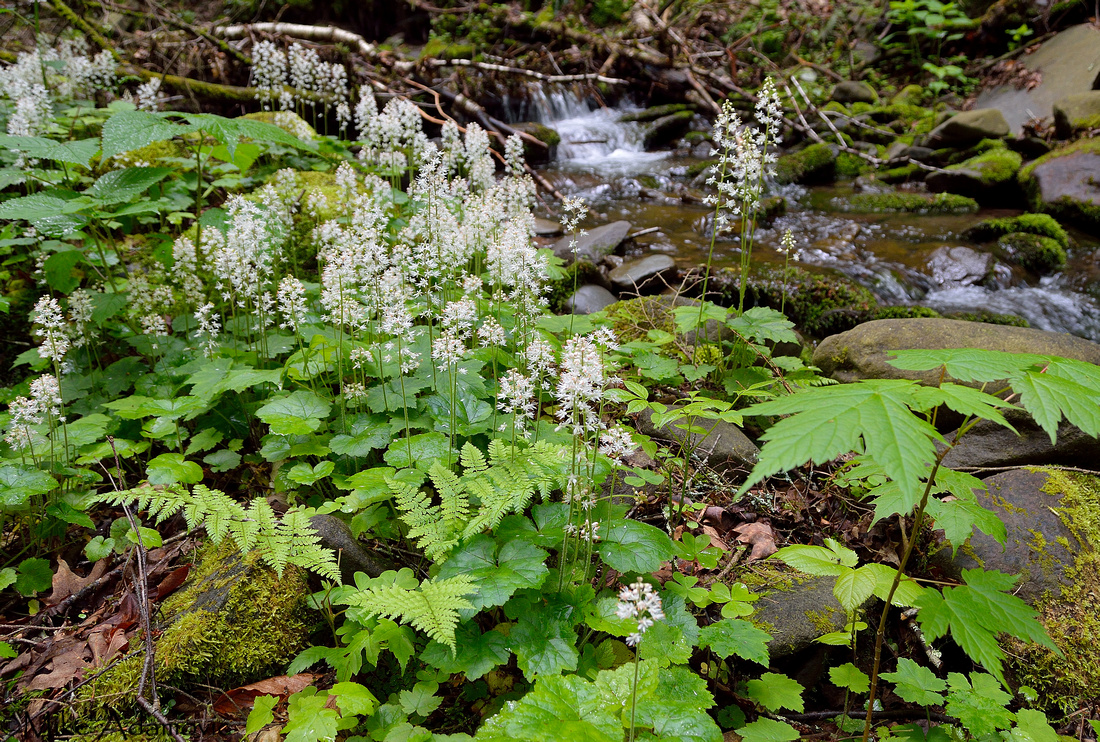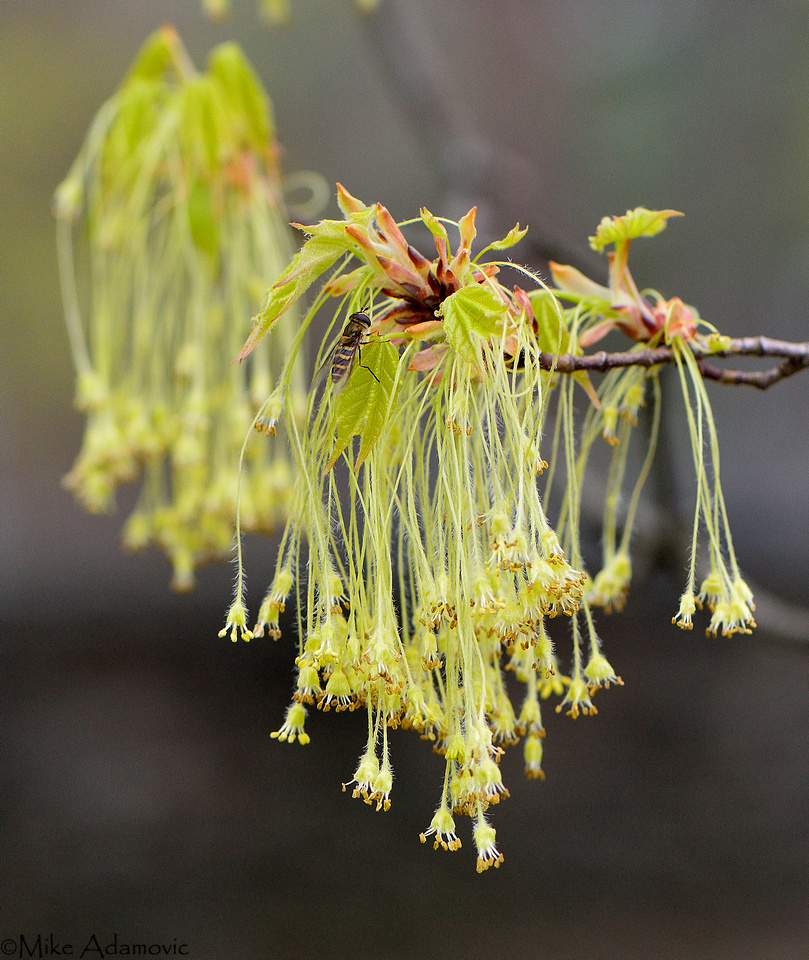Spring in Northeastern Woodlands


Though the initial signs of spring are at first slight, the dead and dull landscape quickly transforms into a vibrant patchwork of multi-hued color upon the first significant warm spell. From the latter half of March to early May, depending on the weather and climate of the area, the first bit of color to emerge is among the upper reaches of the forest. Buds of various species begin to swell with the increased warmth and typically display dullish tints of red or red-brown, that as the early spring season progresses, produces a haze that hangs over the landscape.
Red maples produce the most vibrant show by means of their tiny, yet vivid red—and to a minor extent—yellow flowers. When it comes to our native trees, few associate them with flowers, except, of course, when it comes to the showy dogwoods, redbuds, and tulip trees. But most trees do put on a floral show, though most are rather inconspicuous. While the flowers of the red maple are small, many tree species have even tinier blossoms that lack much in the way in pigment and are pale green or yellow, and also lack the general shape of what the average person would consider a flower. Walking under a red maple and gazing up at the branches, one can see thousands of roundish clusters that look like dots in some abstract painting of the pointillistic type. Closer inspection reveals these "dots" are made up of multiple blossoms. This species produces separate male and female flowers. While most red maples bear flowers of only one sex, some trees do possess both, though each gender is typically confined to a separate branch.
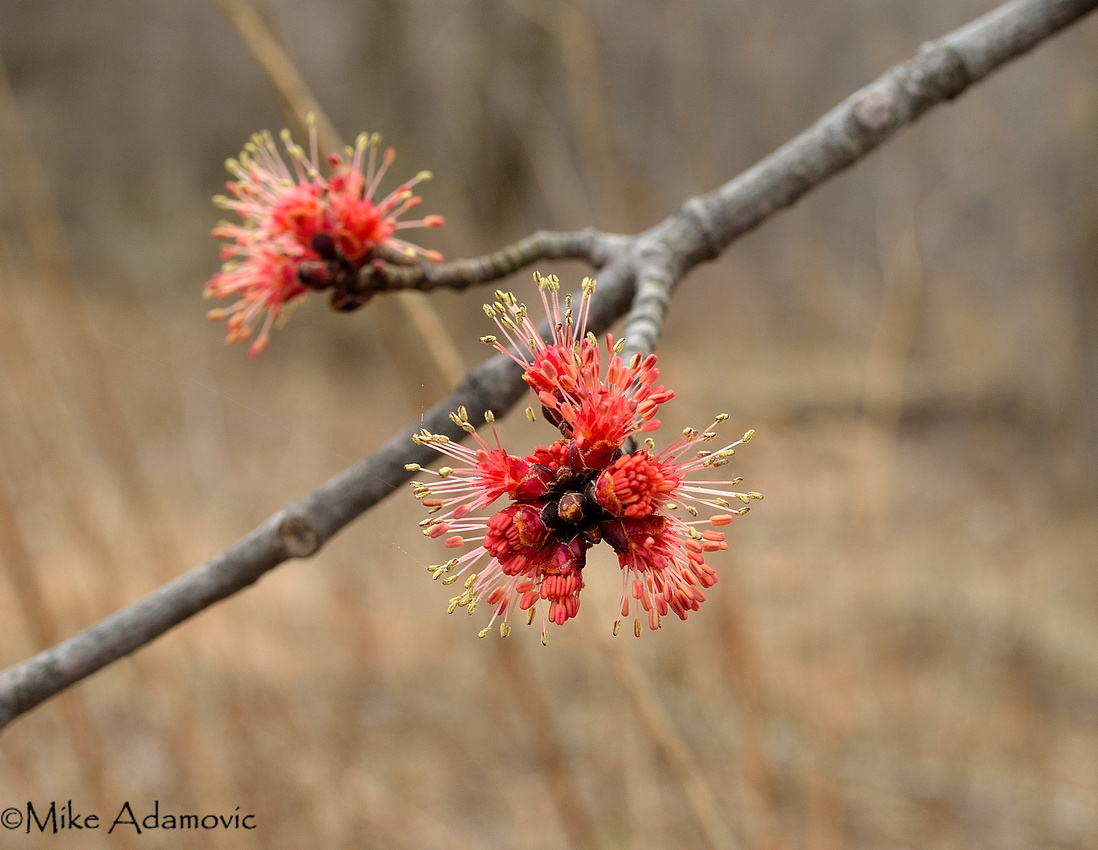

The larger, more perfectly round clusters are male. Each individual flower contains at least a dozen pollen-bearing anthers. At first emergence the anthers are pale red, but as they gradually rise up, supported atop a long, wiry filament they turn yellow from the exuded pollen. Females, by contrast, are compact. While less obvious from a distance, close-up, they rival their male counterparts in elegance. The stigmas of the females are a rich red and have a texture of the purest velvet.
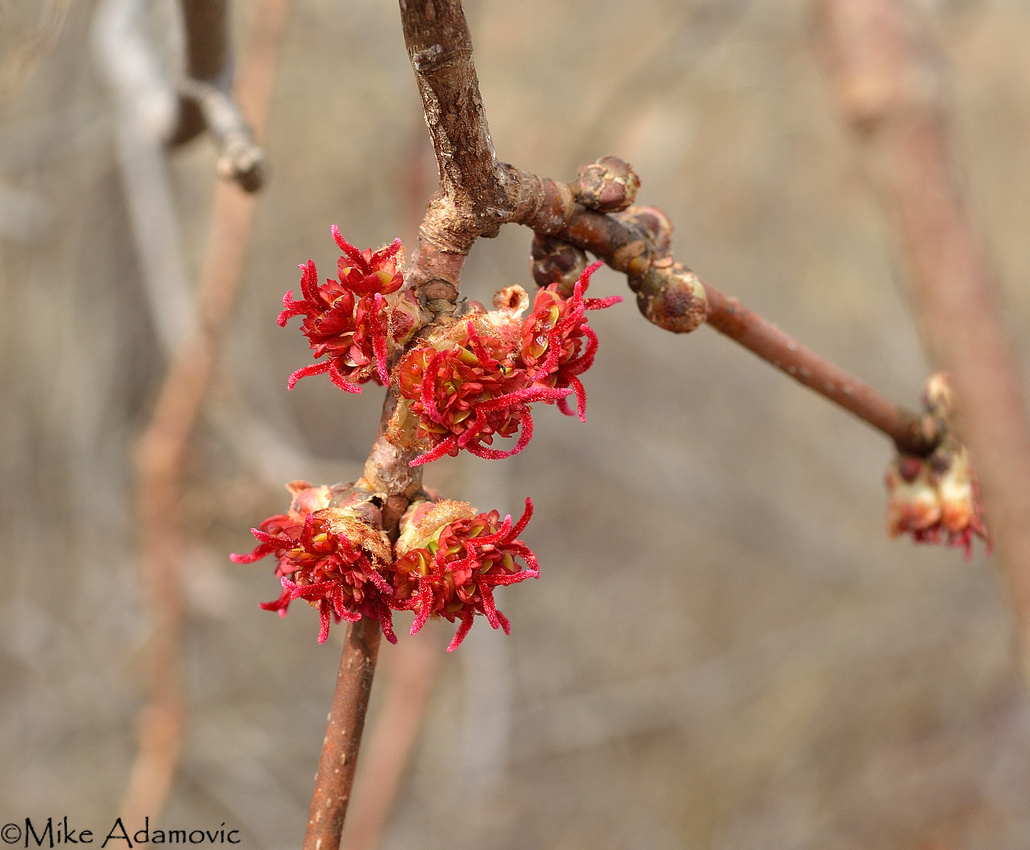
 Spicebush, a shrub of moist lowlands, matches red maple in terms of the hazy effect of its blossoms. In the right setting spicebush often forms expansive thickets. When in bloom, massed shrubs produce a yellow haze in the understory that contrasts wonderfully amid the otherwise stark surroundings. It’s increasingly being used as a native alternative to forsythia and is the prime host plant of the adorable spicebush swallowtail larvae.
Spicebush, a shrub of moist lowlands, matches red maple in terms of the hazy effect of its blossoms. In the right setting spicebush often forms expansive thickets. When in bloom, massed shrubs produce a yellow haze in the understory that contrasts wonderfully amid the otherwise stark surroundings. It’s increasingly being used as a native alternative to forsythia and is the prime host plant of the adorable spicebush swallowtail larvae.
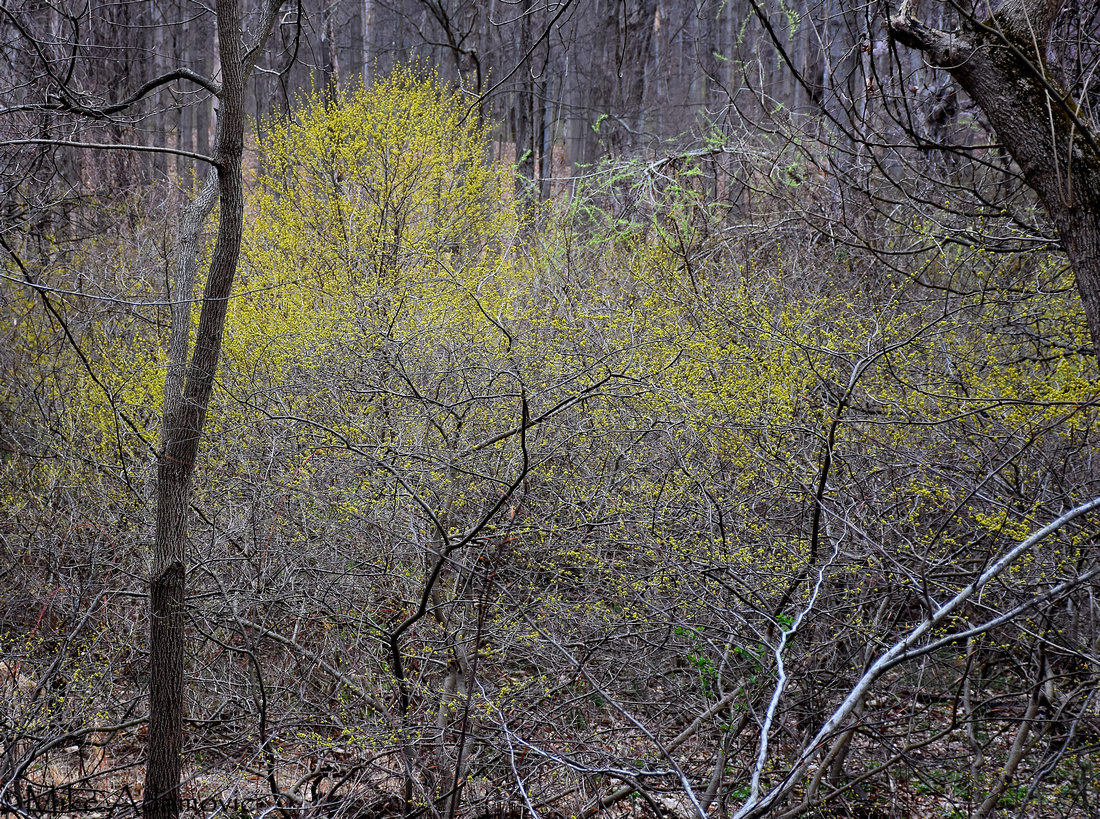
 While the majority of pollination in flowering plants takes place by aid of insects, trees widely rely on the wind for pollen transfer, hence the often times small and unassuming flowers. Vibrant and scented blossoms evolved directly to draw insects. Without a need for pollinators the plants will not waste energy to create a showy floral display. Instead, wind pollinated trees use their resources to create vast quantities of pollen. Such hefty amounts are needed simply because this type of delivery method is unreliable. Imagine trying to deliver a letter to someone in your neighborhood. If you expect to have the letter land on a particular doorstep by throwing it into the wind, you’re probably going to need thousands to millions of extra copies in order to ensure it arrives at the desired spot. Insect pollination is equivalent to using a postal service. It's just much more efficient. Thus, plants that utilize insects produce significantly smaller quantities of pollen.
While the majority of pollination in flowering plants takes place by aid of insects, trees widely rely on the wind for pollen transfer, hence the often times small and unassuming flowers. Vibrant and scented blossoms evolved directly to draw insects. Without a need for pollinators the plants will not waste energy to create a showy floral display. Instead, wind pollinated trees use their resources to create vast quantities of pollen. Such hefty amounts are needed simply because this type of delivery method is unreliable. Imagine trying to deliver a letter to someone in your neighborhood. If you expect to have the letter land on a particular doorstep by throwing it into the wind, you’re probably going to need thousands to millions of extra copies in order to ensure it arrives at the desired spot. Insect pollination is equivalent to using a postal service. It's just much more efficient. Thus, plants that utilize insects produce significantly smaller quantities of pollen.
Wind pollination increases in frequency as latitude increases. First, it's generally windier in northern locales. But more importantly, the diversity of trees is much lower in higher latitudes. For the best odds of fertilization, it's necessary to have as few impediments as possible. In the north, where there are comparatively few species, pure stands of a single species often exist and pollen transfer is readily guaranteed. But in the tropics, where diversity is high, and plants of the same species may be extremely scattered, pollen given to the wind would likely never reach its intended target.
Conifers, along with some angiosperms, utilize this primitive pollination system. It can be seen best in the Adirondacks, White Mountains, and other northern reaches of the region that are occupied by boreal and transitional forests. In late spring it's a mistake to park your car beneath these pollen-laden trees. Only a handful of them are needed to create billowing sheets of golden fog that thickly coat everything around when spring gusts rush through the branches. Oaks, willows, and alders are also wind pollinated. These deciduous species have pollen attached to long, drooping flower clusters called catkins which dangle from the ends of branches. Red maples are primarily pollinated by insects, but pollen is also carried by the wind to a minor extent.
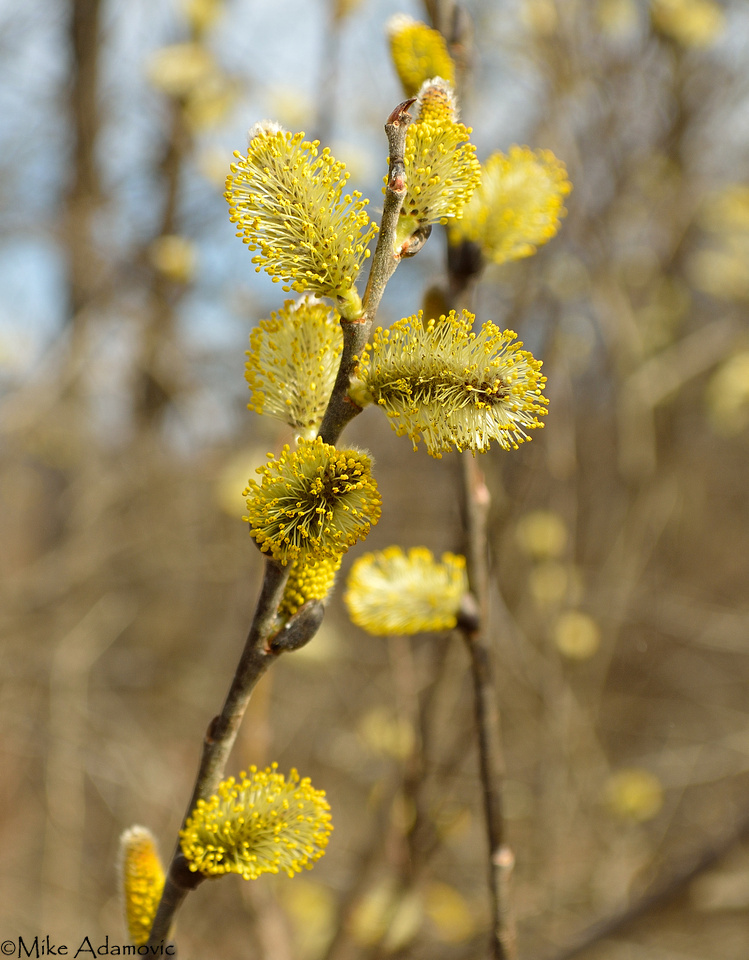

Shortly after the first trees begin to awaken, the wildflowers of the understory are also roused from their long slumber, eager to bloom before the overarching trees leaf out and steal precious light. In quick succession, woodland spring ephemerals put on displays as magnificent as a 4th of July firework show. Those who wish to view this anticipated and fleeting spectacle must be quick about getting out. Some species are in bloom but a day or two before the wind and rain takes the petals away, as is the case with the fragile bloodroot.
Spring ephemerals, like most plants, follow a regimented blooming pattern that varies very little from year to year in terms of sequence.
The first to make an appearance is the unimpressive skunk cabbage. Apart from lacking flowers with any remarkable éclat, crushed portions of the plant emit an unpleasant odor much as the name implies. While skunk cabbages usually make an appearance during the latter half of March, sometimes they appear significantly earlier. I've seen this plant poke its head out along the edges of mucky streams during early February in the midst of the most minor of thaws. This may seem highly unusual for the normally dainty wildflowers, but the skunk cabbage isn't like other spring ephemerals. The flowers, which are partially hidden inside a cone-like structure called a spathe, are merely tiny dots studded across what resembles a rotten egg, both in sight and scent. For this, "the plebian skunk cabbage...ought scarcely to be reckoned among true flowers," according to Neltje Blanchan, an early 20th century wildflower expert. They also exhibit a unique trait in the plant world known as thermogenesis, which is why it's possible for such an early bloom date when other plants are still trapped below the frozen ground. This trait allows skunk cabbages to produce heat, similarly to warm-blooded animals. With generated temperatures rising to 90° F, it's easy for them to melt their way through standing snow and ice.

 The next to emerge is the non-native coltsfoot, bearing bright, cheery yellow flowers that could be mistaken for dandelions if they were to appear in front yards—they rarely do. Coltsfoot is fond of soggy or muddy roadsides usually scant of vegetation. The scaly stem and initial lack of leaves differentiate this species from its much-despised lawn destroying cousin.
The next to emerge is the non-native coltsfoot, bearing bright, cheery yellow flowers that could be mistaken for dandelions if they were to appear in front yards—they rarely do. Coltsfoot is fond of soggy or muddy roadsides usually scant of vegetation. The scaly stem and initial lack of leaves differentiate this species from its much-despised lawn destroying cousin.
Hepatica usually opens its buds just after coltsfoot appears. Despite the nearly concurrent displays, these species are rarely seen together. Hepatica grows among the interior of moist woodlands. Its multiple color morphs ranging from pure white to pink to the deepest violet stand out among the stark environs of the leaf-littered understory. "When at the maturity of its charms, it is certainly the gem of the woods," the naturalist John Burroughs once admiringly wrote. Two forms of hepatica exist in the eastern U.S., primarily differentiated by leaf shape. Blunt-lobed hepatica has rounded, or blunt leaves, while those of the sharp-lobed variety come to a point at the tip. Apart from physical characteristics, habitat preferences differ as well. The blunt-lobed form typically inhabits upland environments with acidic soil; sharp-lobed hepatica is found more often in moist lowlands, containing richer and more neutral soil. These two varieties, or subspecies, were once considered to be distinct species, but over the years taxonomists have revised their opinions, deciding that these differences aren't substantial enough to warrant a completely separate classification.


Right around the time hepatica is in bloom the mottled leaves of the trout lily start to emerge along gravelly riverine plains and throughout damp forests generally not far from a wetland or other water source. While the leaves appear early, the yellow flowers lag behind a couple weeks, blooming usually around the middle of April. Trout lilies, like numerous other spring ephemerals, are able to produce blossoms so early in the spring season through use of the energy reserves stored in the root-like corms. Expansive, long-lived colonies often develop. The average age of most colonies is about 150; some have been recorded to be as much as 1,300 years old. Though these plants often carpet the forest floor in the thousands with their artsy leaves, don't expect to come across a sea of yellow flowers. It's been estimated that only 1% of plants will bloom. This is probably because trout lilies rely more on vegetative propagation than reproducing by means of seeds.
Up until the early days of the 20th century, this plant boasted a plethora of names, a few of which, really didn't fit the plant at all. "It is a pity that this graceful and abundant flower," John Burroughs lamented, "has no good and appropriate common name." "Dog-tooth violet" and "adder's-tongue" were most frequently used. He put forth a flurry of theories as to why these names were bestowed. In terms of the dog-tooth violet appellation, he theorized that the color and shape of the unopened buds resembled canine teeth; yet the violet part puzzled him, as it "has not one feature of a violet." Others have suggested it was so-called due to the shape of the plant's corms. Adder's-tongue, he thought, derived from the "spotted character of the leaf," because it vaguely resembles the patterns on the skin of some snakes. Neltje Blanchan, on the other hand, proposed that the name came about from the "sharp purplish point" of young plants as they first emerge above ground, clearly resembling a little serpentine tongue.
Burroughs propounded the name trout lily, and is generally credited with its now widespread use. In his book, Riverby, he concisely stated: "It blooms along the trout streams, and its leaf is as mottled as a trout's back." He was also fond of "fawn lily" too—again, in relation to the spotted nature of the leaves.
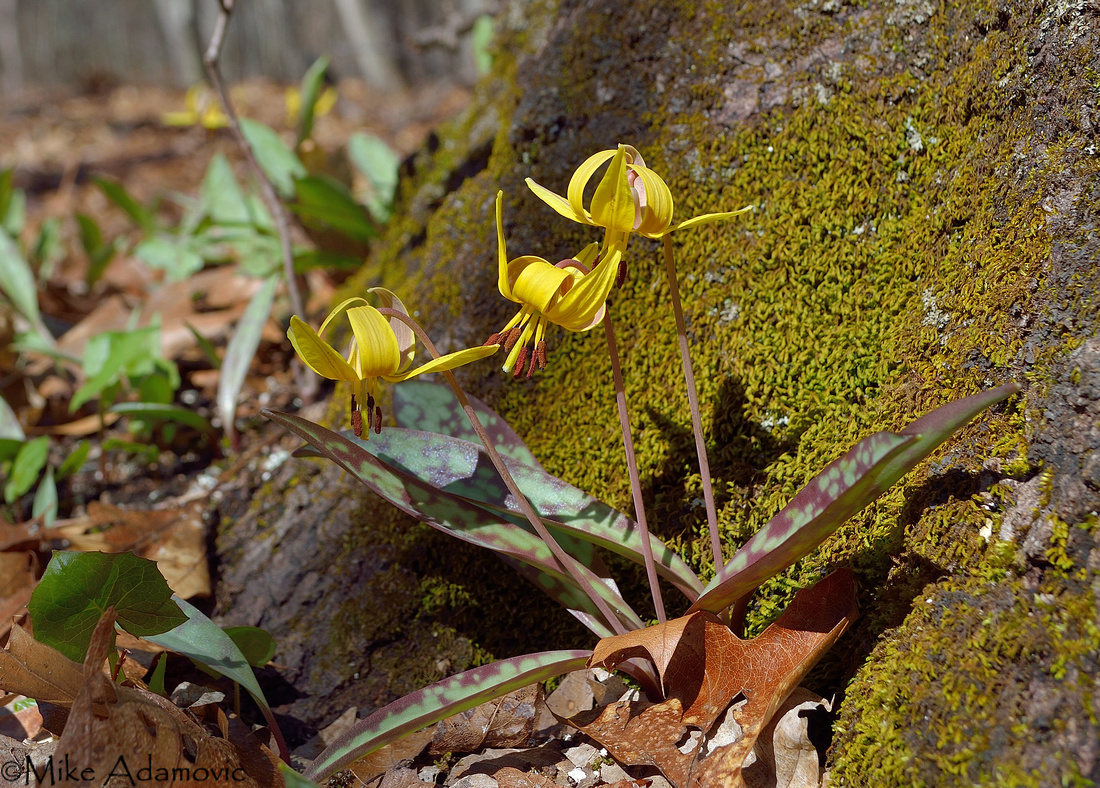

Before the blossoms of the trout lily can be seen gently nodding in the early spring breezes, seemingly still drowsy from their winter torpor, arguably the most stunning ephemeral of the spring season rises quickly and gracefully from the newly softened ground. Bloodroot, whose ivory petals surround a bright, golden center is one of the most short-lived of our wildflowers. Within a day or two of surfacing, the single bud produced by each plant opens, and senescences within a similar time frame. Seed pods soon develop and swell, sitting atop the stem like an inverted watermelon.
Like several other spring ephemerals, bloodroot uses ants as a means of seed dispersal, a technique known as myrmecochory. Attached to each tiny seed is a fleshy appendage called an elaiosome that’s rich in protein and lipids, but serves no direct impact to the seed’s survival. Like the sweet nectar of a flower, these elaiosomes are tempting treats to insects. Ants, in particular, are readily enticed to collect them. Once dragged back to the colony, the energy-laden accessory is removed for consumption, and the hard seed body is dumped in waste pits that provide an enriched medium for growth. In this way, bloodroot is able to colonize new locales away from the parent plant and ensure optimal germination. While new colonies are formed from seeds, and preexisting ones receive a supplemental boost, tightly knit colonies are a result of vegetative propagation, another form of reproduction which produces clones by extension of rhizomes.
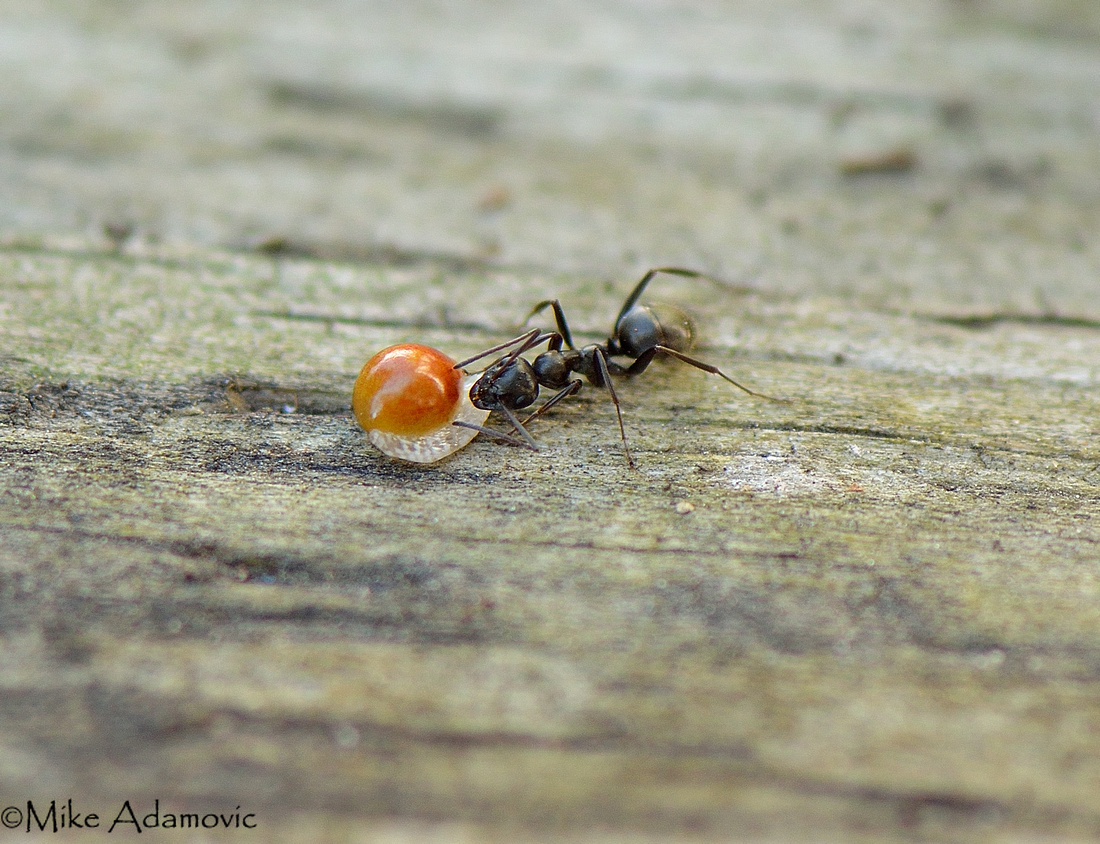
 Large colonies, or drifts, will sometimes form in areas of especially prime habitat, consisting in the hundreds—and rarely thousands—of individuals. More often than not, they will be found along some type of waterbody, be it a river, lake, or even a temporary rivulet born of snowmelt. While these colonies are normally significantly smaller than those formed by trout lilies, an almost synchronous blooming elevates them to another level.
Large colonies, or drifts, will sometimes form in areas of especially prime habitat, consisting in the hundreds—and rarely thousands—of individuals. More often than not, they will be found along some type of waterbody, be it a river, lake, or even a temporary rivulet born of snowmelt. While these colonies are normally significantly smaller than those formed by trout lilies, an almost synchronous blooming elevates them to another level.
The large blossoms, as well as the glaucous, almost succulent leaves, create a striking scene among the withered foliage and broken stems of last year’s growth. A particularly large, showy colony is easily spotted at a considerable distance and visually eclipses other ephemeral populations that attain a similar size. There’s something entrancing and fairy-like in the demeanor of these somewhat uncommon flowers, with their unique ability to pop-up seemingly overnight, transforming the landscape like magic. Such vigor and color contrasts greatly with the bleak debris that surrounds, creating an image of unsurpassed beauty that’s sure to be emblazoned in memory and sought out year after year.
As the name portrays, these plants do indeed possess crimson roots. Moreover, this species bleeds the same as any injured animal. A broken leaf or stem causes the plant to exude a fluid alarmingly similar to blood. It stains anything it touches, and has been used in years past as a dye by both Native Americans and colonists.
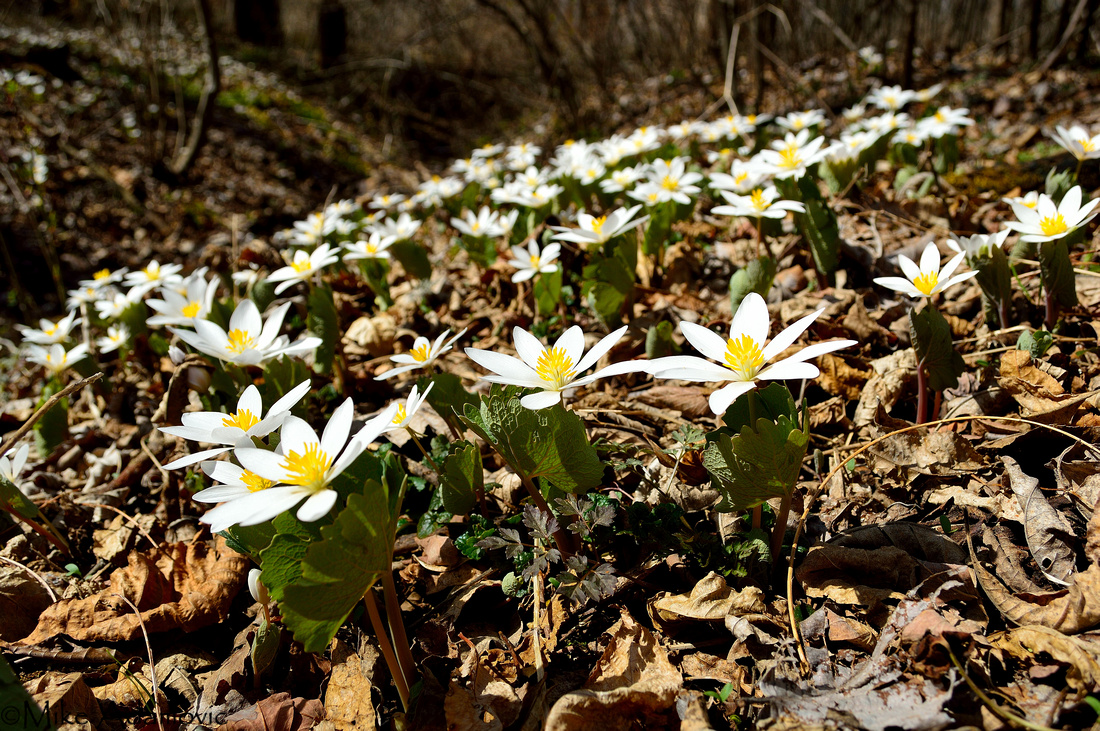

Wild violets are perhaps the least appreciated of our wildflowers. Though often distracted by other showier and perhaps rarer flowers, the common, yet regal violets, are a fascinating genus to delve into, and shouldn’t automatically be dismissed solely due to their profusion. While many violets share numerous similarities and are extremely difficult to differentiate from one another, it has been estimated that there are, in fact, between 500-600 species worldwide, approximately 85 of which can be found growing in North America. There’s tremendous variation among the community, with many varieties garnering oxymoronic names, such as round-leaved yellow violet and sweet white violet. While a majority do live up to their names in appearance, there’s more than a few that are anything but violet, being completely white, and even the brightest shade of yellow, with numerous combinations and levels of mixing.
Yellow violets appear to be the most primitive, with their flowers being the first shift away from the ancestral green. Purple, in contrast, is thought to be one of the most advanced colors. Evolution in progress can be witnessed in the Canada violet, a native to Canada and the eastern U.S. Many botanists speculate that the mostly white flower, often dabbed with minor purplish tingeing on the back of the petals, is transitioning from entirely white to “violet.”

 Violets fall into two general categories: those that are stemmed and have leaves and flowers protruding from them, and those that are stemless, having appendages emanating directly from the roots, with flowers being supported on a thin and usually low, leafless stalk. Breaking it down further, certain species, in addition to having showy blossoms, possess a trait known as cleistogamy, meaning they are capable of self-pollinating by means of tiny, barely noticeable flowers that resemble unopened buds.
Violets fall into two general categories: those that are stemmed and have leaves and flowers protruding from them, and those that are stemless, having appendages emanating directly from the roots, with flowers being supported on a thin and usually low, leafless stalk. Breaking it down further, certain species, in addition to having showy blossoms, possess a trait known as cleistogamy, meaning they are capable of self-pollinating by means of tiny, barely noticeable flowers that resemble unopened buds.
Once fertilization has occurred by means of insects or self-pollination, the seeds are ready for an explosive dispersal. After the seeds are fully developed, the pods they’re stored in slowly dry out, with the pod gradually tightening around the seeds, building up tension in the process, similarly to the action of a spring. Later, when the pods are disturbed, or sometimes just randomly, the pressure becomes too great and the seeds are shot out like miniature cannonballs. Amazingly, seeds are capable of being flung up to 15 feet away from the parent plant.
Insects aren’t the only ones to appreciate the tasty nature of the violet. Nearly all parts of the plants are edible for human consumption. The leafy greens can be collected to create a salad that’s high in vitamins A and C, superseding that of an equal quantity of oranges. Beginning in the 19th century, candied violets gained favor as a dessert garnishment and were widely served. Though their popularity has decreased over the years, in some circles they're still a favorite topping for sweet dishes of cake or ice cream. Traditionally, a syrup was also made by boiling the flowers in a concoction of sugar. Apart from sweetening the lips, the syrup is useful as a substitute for litmus paper. The solution turns red in the presence of an acid, green for a base.

 Red trillium, while lovely in sight, with its three or tri-petaled (hence trillium), maroon-hued flowers, shares traits in common with the less beloved and odiferous skunk cabbage. Unlike other spring ephemerals whose blossoms are sweetly scented or have no scent at all, this trillium stinks like a wet dog. Called wake-robin by some because of its appearance when robins are migrating back north, it also garners the more piquant name of "stinking Benjamin." The putrid scent appears to have evolved to attract flies for pollination—the same that normally feast on dead and decaying animals. The coloration of trillium, along with the that of the skunk cabbage's spathe, are similar in hue to carrion, which also appears to help draw in flies. This plant often grows alongside trout lilies and bloodroot, but is more tolerant of shade. Flowers appear from the latter half of April through the first half of May. The more beautiful and sweet-smelling painted trillium inhabits cooler locales, frequently of higher elevation, and is more common northward.
Red trillium, while lovely in sight, with its three or tri-petaled (hence trillium), maroon-hued flowers, shares traits in common with the less beloved and odiferous skunk cabbage. Unlike other spring ephemerals whose blossoms are sweetly scented or have no scent at all, this trillium stinks like a wet dog. Called wake-robin by some because of its appearance when robins are migrating back north, it also garners the more piquant name of "stinking Benjamin." The putrid scent appears to have evolved to attract flies for pollination—the same that normally feast on dead and decaying animals. The coloration of trillium, along with the that of the skunk cabbage's spathe, are similar in hue to carrion, which also appears to help draw in flies. This plant often grows alongside trout lilies and bloodroot, but is more tolerant of shade. Flowers appear from the latter half of April through the first half of May. The more beautiful and sweet-smelling painted trillium inhabits cooler locales, frequently of higher elevation, and is more common northward.
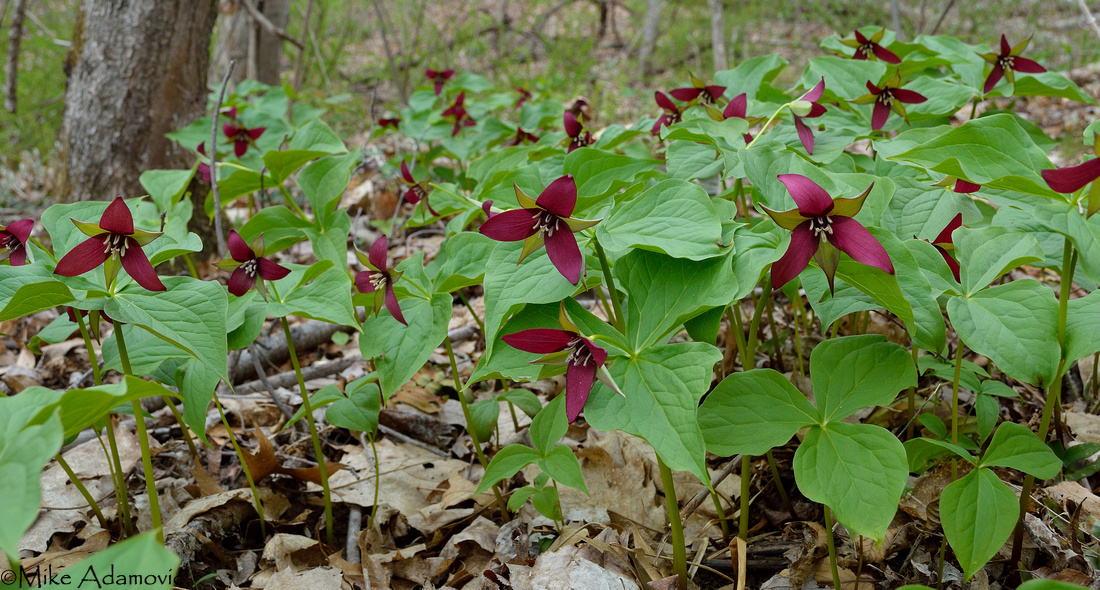
 Wild ginger is likely to go unnoticed unless the passerby recognizes the leaves, which form lush moderately-sized colonies, often right alongside hiking trails. Each plant bears a single small, stubby flower that hides beneath the foliage and lies on the ground, or is elevated just above it. Like red trillium, the dark purple to maroon hue is identical to that of newly thawed carrion and attracts flies for pollination. Though not related to the ginger sold in grocery stores, the root of this plant reportedly has a taste very similar to it. It is also reported to have mild antibacterial properties. It was used by regional Indians to prevent meat from spoiling. When it comes to fishing, it’s reputed that the root, when applied to bait, strongly enhances its performance.
Wild ginger is likely to go unnoticed unless the passerby recognizes the leaves, which form lush moderately-sized colonies, often right alongside hiking trails. Each plant bears a single small, stubby flower that hides beneath the foliage and lies on the ground, or is elevated just above it. Like red trillium, the dark purple to maroon hue is identical to that of newly thawed carrion and attracts flies for pollination. Though not related to the ginger sold in grocery stores, the root of this plant reportedly has a taste very similar to it. It is also reported to have mild antibacterial properties. It was used by regional Indians to prevent meat from spoiling. When it comes to fishing, it’s reputed that the root, when applied to bait, strongly enhances its performance.

 Marsh marigold is perhaps one of the finest flowers of spring, at least when it comes to watery environs. As its name implies, it prefers saturated soil, common to marshes, swamps, and other perpetually damp areas. Blooming amid masses of newly greening skunk cabbages and the withered remains of last year’s growth, the flowers brighten up the often gloomy surroundings like a handful of gold coins tossed onto the muck, shimmering radiantly with even the smallest bit of light.
Marsh marigold is perhaps one of the finest flowers of spring, at least when it comes to watery environs. As its name implies, it prefers saturated soil, common to marshes, swamps, and other perpetually damp areas. Blooming amid masses of newly greening skunk cabbages and the withered remains of last year’s growth, the flowers brighten up the often gloomy surroundings like a handful of gold coins tossed onto the muck, shimmering radiantly with even the smallest bit of light.
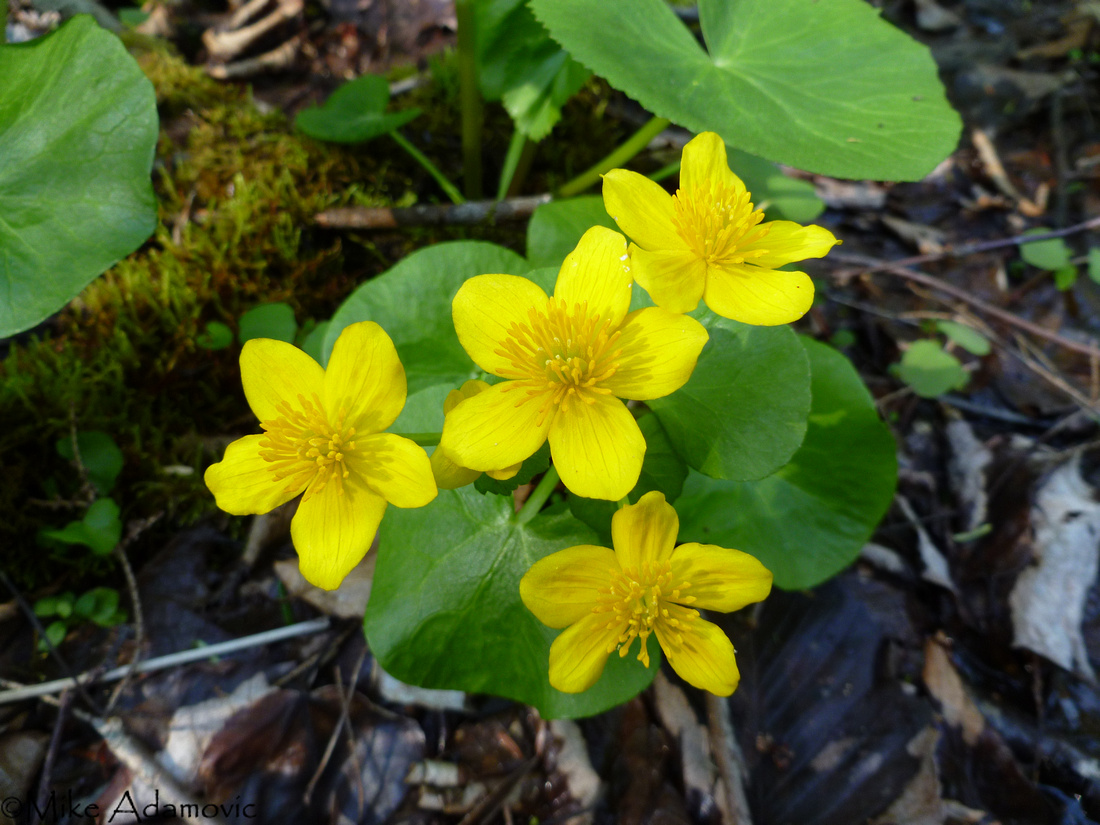
 One of the most unusual of the spring ephemerals to be seen is the comically named Dutchman’s breeches that happen to resemble an upturned pair of outdated pantaloons. It’s been conjectured that the odd-looking flowers are useful for safeguarding the precious pollen and nectar from the harsh spring elements. With the nectar sequestered at the very top of the flower, it’s also protected against small insects which might otherwise steal the sweet reward without pollinating the plant. Only insects with exceedingly long tongues, such as bumblebees, can reach the nectar and effectively aid in pollination. Some thieving insects will bypass this clever design by chewing a hole through the flower, however.
One of the most unusual of the spring ephemerals to be seen is the comically named Dutchman’s breeches that happen to resemble an upturned pair of outdated pantaloons. It’s been conjectured that the odd-looking flowers are useful for safeguarding the precious pollen and nectar from the harsh spring elements. With the nectar sequestered at the very top of the flower, it’s also protected against small insects which might otherwise steal the sweet reward without pollinating the plant. Only insects with exceedingly long tongues, such as bumblebees, can reach the nectar and effectively aid in pollination. Some thieving insects will bypass this clever design by chewing a hole through the flower, however.
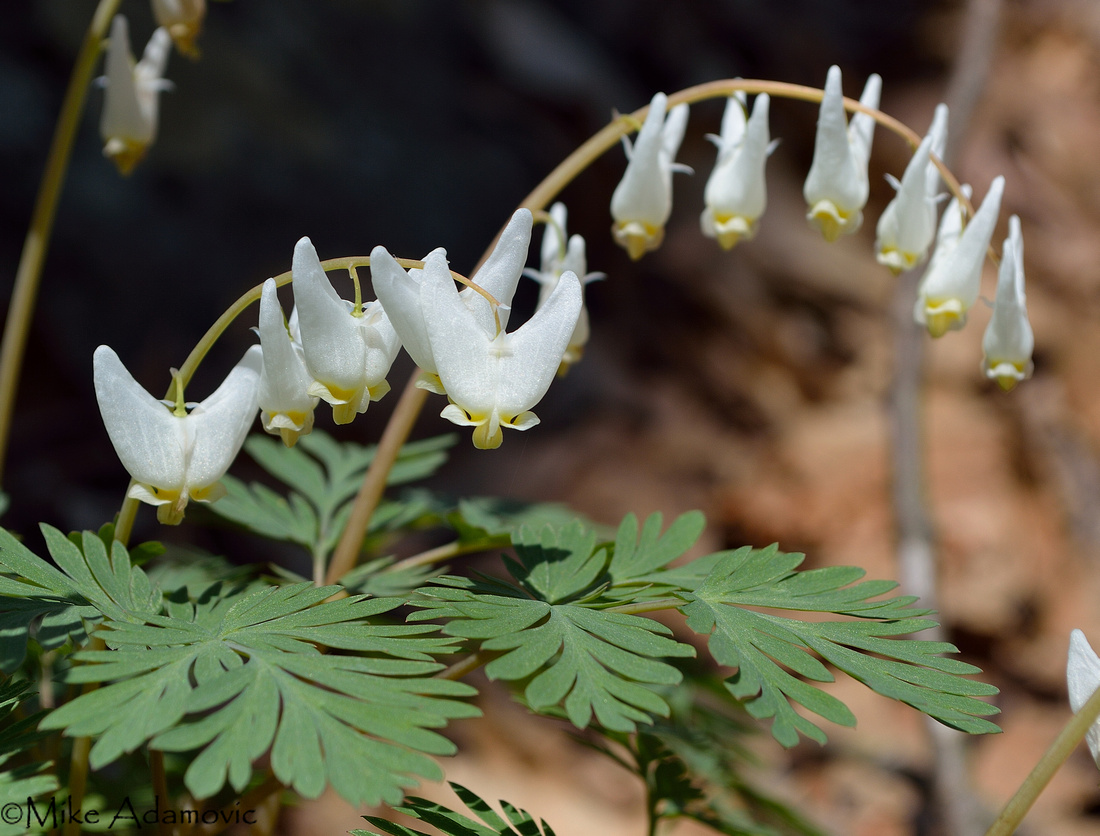
 The foliage of the mayapple is on par with the beauty of its flowers. Resembling green umbrellas, dual leaves stand firmly erect sheltering a rather robust white blossom beneath. Plants typically form dense colonies that can take over sizeable swaths of the understory, shading out all other plant life by means of its expansive leaves. It makes an attractive groundcover. While the flowers bloom in May, the fruit, or “apple,” will not appear until August or September. The fruit is edible when ripe, supposedly tasting like a tart lemon. All other parts of the plant are extremely toxic, including unripe fruit. Native Americans used the root as a means to commit suicide. Despite the encompassing size of some colonies, mayapple is a rather uncommon plant whose scarcity in our woods is increasing.
The foliage of the mayapple is on par with the beauty of its flowers. Resembling green umbrellas, dual leaves stand firmly erect sheltering a rather robust white blossom beneath. Plants typically form dense colonies that can take over sizeable swaths of the understory, shading out all other plant life by means of its expansive leaves. It makes an attractive groundcover. While the flowers bloom in May, the fruit, or “apple,” will not appear until August or September. The fruit is edible when ripe, supposedly tasting like a tart lemon. All other parts of the plant are extremely toxic, including unripe fruit. Native Americans used the root as a means to commit suicide. Despite the encompassing size of some colonies, mayapple is a rather uncommon plant whose scarcity in our woods is increasing.

 The last of the spring wildflowers to bloom is the fiery red columbine, beginning its display in mid-May and lasting until the closing of June. The chandelier-like blossoms, which are mostly red, but sport a rich, golden underside, have been described to possess an “elfin charm” and a splendor which isn’t anything less than “magical and audacious.”
The last of the spring wildflowers to bloom is the fiery red columbine, beginning its display in mid-May and lasting until the closing of June. The chandelier-like blossoms, which are mostly red, but sport a rich, golden underside, have been described to possess an “elfin charm” and a splendor which isn’t anything less than “magical and audacious.”
Red columbine is a wide-ranging perennial that occupies the eastern half of the United States. Flowers are typically 1.5 inches long and borne on plants growing 1-2 feet tall. This species has an affinity for slightly alkaline to neutral soil. It’s able to thrive in places most other plants can’t even gain a minor foothold. It’s not uncommon to find a copious profusion of flowers sprouting from a vertical cliff face. The roots are able to penetrate the tiniest of cracks and subsist on the barest amounts of soil. Columbine is also likely to be found gracing spongy beds of moss within open and somewhat sunny forests.
Red flowers throughout temperate forests are usually rather scarce. In many cases, this color appears to have evolved to attract hummingbirds. The long, tubular structures of the columbine flowers attest to this. Nectar is sequestered at the base of each lengthy tube; only creatures with long beaks or tongues are able to reach it. It has been speculated that the yellow underside is a mechanism to guide potential pollinators to the sweet reward. Apart from hummingbirds, bumblebees are probably one of the few other pollinators able to access it. Some insects, however, may cheat the system and chew a hole through the flower to rob it of nectar, similarly to Dutchman’s breeches—in such a case, flowers fail to be pollinated.
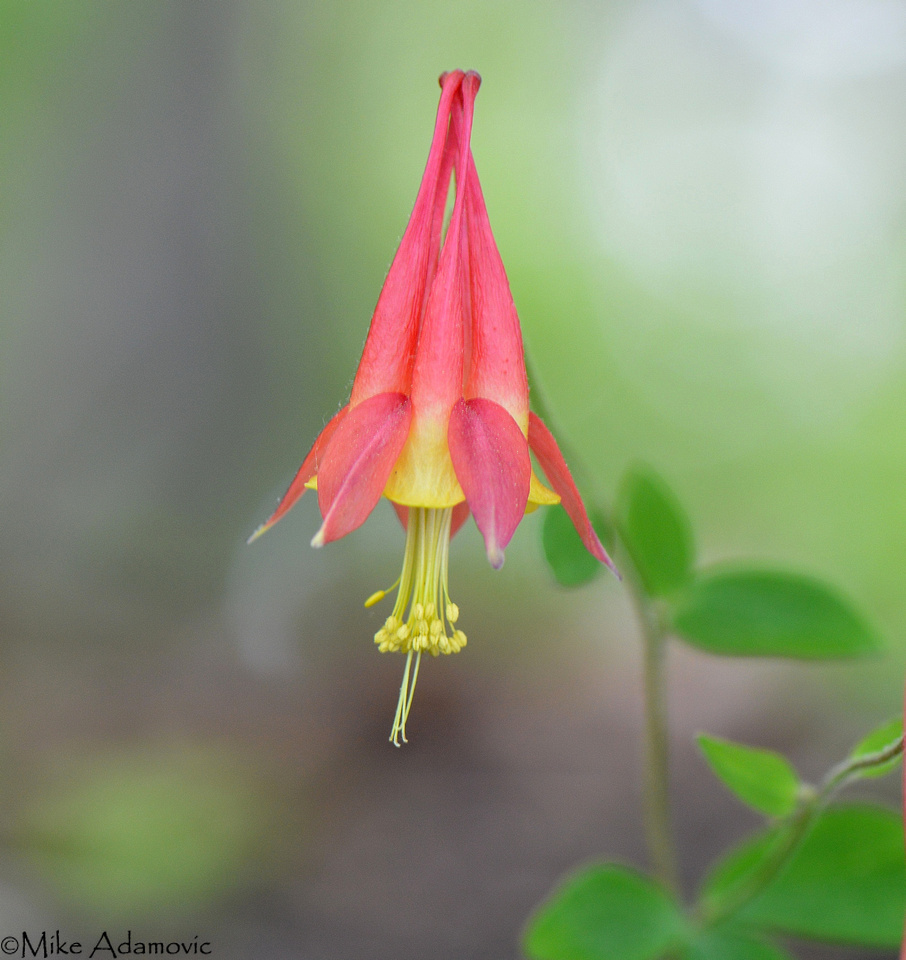
 The spring ephemerals just described are some of the more commonly encountered throughout the region, but the list is far from complete. A thorough inventory mentioning each species is too lengthy to include here. There are other interesting species worth simply noting, however.
The spring ephemerals just described are some of the more commonly encountered throughout the region, but the list is far from complete. A thorough inventory mentioning each species is too lengthy to include here. There are other interesting species worth simply noting, however.
It's wise to be on the lookout for the tightly clustered bluets, which true to their name are mostly of an azure or sky-blue hue and often grace sunny pastures and meadows, along with sprouting along the edges of woodland hiking trails where abundant light penetrates to the ground. And then there's the delicate dwarf ginseng, which closely resembles its rare and exploited relative, American ginseng. The dwarf is exceedingly more common, on account of it lacking the size and potency of its larger cousin, and thus never having been collected in meaningful numbers. On high hills and low mountains, the tall corydalises thrive on dry, rocky ledges. Pink flowers are borne on the common species, golden on the rare.
Plants with an affinity for alkaline soils are generally rarer than their acid loving brethren in the Northeast. Part of the reason for this is that alkaline habitats are relatively scarce, a result of the underlying geology of the region. The wild purple clematis, a delicate flowering vine producing blue-purple flowers with a crepe paper look, prefers to vegetate around damp rocky habitats, such as talus slopes and cliff sides that possess more basic or alkaline pH. Twin-leaf, a plant in many ways identical to bloodroot, except for its higher pH preference and that each leaf is bisected and looks like a pair of butterfly wings, is rather rare and is on the threatened or endangered plant lists of New York and New Jersey.
As the spring ephemerals wrap things up for the season, the shrubs and trees begin their leafy show, draping all the landscape in the soft verdure that we that we take delight in seeing, knowing the warm and pleasant days of summer can't be far behind. Shrubs are the first to leaf out after the herbaceous layer of the understory. A layering effect takes place, with the lowest awakening first and the highest last. Come the height of summer when the canopy is fully expanded, sunlight reaching the secondary layers gets progressively smaller as one continues to descend. It's been estimated that only between 1-5% of solar radiation penetrates through to the forest floor. Plants of the understory compensate for the lack of summer light by gaining a head start in the spring. Unfortunately, the earliest shrubs to begin leafing are exotic species, such as Japanese barberry and honeysuckle. This is detrimental to some ephemerals who are shaded out prematurely by the often times prolific invaders that not only block light, but steal nutrients and considerably alter the environment in other ways.
